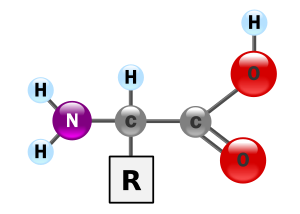Amino acid facts for kids
Amino acids are like the tiny building blocks that our bodies use to make something super important: proteins! Think of them as the letters of an alphabet. Just like you can make many different words and sentences with a few letters, your body uses about 20 main types of amino acids to create thousands of different proteins. These proteins do all sorts of jobs, from building muscles to helping you digest food.
In simple terms, an amino acid is a special kind of molecule that has two main parts: an "amine" group and a "carboxyl" group. What makes each amino acid unique is another part called the "R group" or side chain. This R group is different for each of the 20 amino acids and gives them their special properties.
There are actually about 500 different amino acids found in nature, but only a small number are used to build proteins in humans and other living things. The way these amino acids link together in a long chain determines the protein's shape and what it does. It's like how the order of letters changes a word's meaning!
Some amino acids are called "essential" because your body can't make them on its own. This means you have to get them from the food you eat. For humans, there are 9 essential amino acids. Other amino acids can be made by your body. What's "essential" can even change depending on your age or if you have certain health conditions. Animals like cows get some of their amino acids from tiny living things (microbes) that live in their stomachs!
What Are Amino Acids Made Of?
Every amino acid is a special kind of organic chemical. It has a central carbon atom, often called the "alpha-carbon." This carbon atom is connected to four different things:
- A hydrogen atom
- An amino group (which contains nitrogen and hydrogen)
- A carboxyl group (which contains carbon, oxygen, and hydrogen)
- A special "R group" or side chain
The R group is the part that changes from one amino acid to another. It's what makes Alanine different from Glycine, for example. Almost all amino acids have an amino group and a carboxyl group, except for one called proline.
How Amino Acids Build Proteins
The amino acids that our bodies use to build proteins are called "proteinogenic" amino acids. Our cells have amazing machinery that reads instructions from our genetic code (like a blueprint) to link these amino acids together in the correct order. This process creates all the different proteins our bodies need.
The table below shows the 20 main amino acids used to build proteins in humans. It also tells you if they are "essential" (meaning you need to get them from food) or "conditionally essential" (meaning you might need them from food sometimes).
| Amino Acid | Short Name | Abbreviation | Codons (Genetic Code) | How often found in human proteins (%) | Essential for humans? |
|---|---|---|---|---|---|
| Alanine | A | Ala | GCU, GCC, GCA, GCG | 7.8 | No |
| Cysteine | C | Cys | UGU, UGC | 1.9 | Conditionally |
| Aspartic acid | D | Asp | GAU, GAC | 5.3 | No |
| Glutamic acid | E | Glu | GAA, GAG | 6.3 | Conditionally |
| Phenylalanine | F | Phe | UUU, UUC | 3.9 | Yes |
| Glycine | G | Gly | GGU, GGC, GGA, GGG | 7.2 | Conditionally |
| Histidine | H | His | CAU, CAC | 2.3 | Yes |
| Isoleucine | I | Ile | AUU, AUC, AUA | 5.3 | Yes |
| Lysine | K | Lys | AAA, AAG | 5.9 | Yes |
| Leucine | L | Leu | UUA, UUG, CUU, CUC, CUA, CUG | 9.1 | Yes |
| Methionine | M | Met | AUG | 2.3 | Yes |
| Asparagine | N | Asn | AAU, AAC | 4.3 | No |
| Pyrrolysine | O | Pyl | UAG | 0 | No |
| Proline | P | Pro | CCU, CCC, CCA, CCG | 5.2 | No |
| Glutamine | Q | Gln | CAA, CAG | 4.2 | No |
| Arginine | R | Arg | CGU, CGC, CGA, CGG, AGA, AGG | 5.1 | Conditionally |
| Serine | S | Ser | UCU, UCC, UCA, UCG, AGU, AGC | 6.8 | No |
| Threonine | T | Thr | ACU, ACC, ACA, ACG | 5.9 | Yes |
| Selenocysteine | U | Sec | UGA | >0 | No |
| Valine | V | Val | GUU, GUC, GUA, GUG | 6.6 | Yes |
| Tryptophan | W | Trp | UGG | 1.4 | Yes |
| Tyrosine | Y | Tyr | UAU, UAC | 3.2 | Conditionally |
| Stop codon | - | Term | UAA, UAG, UGA | - | - |
Images for kids
See also
 In Spanish: Aminoácido para niños
In Spanish: Aminoácido para niños





